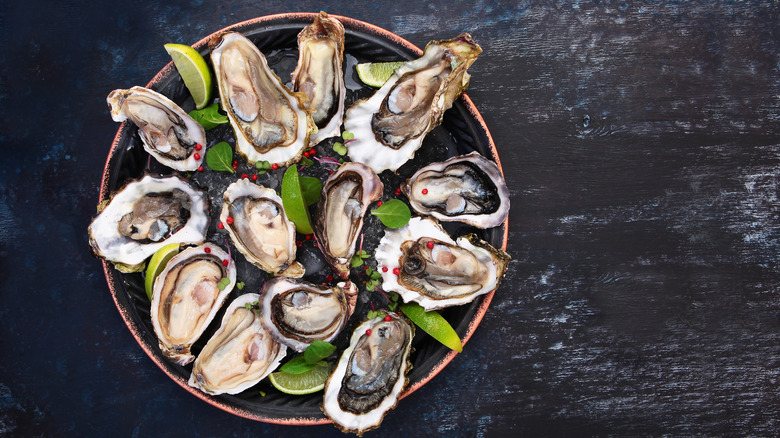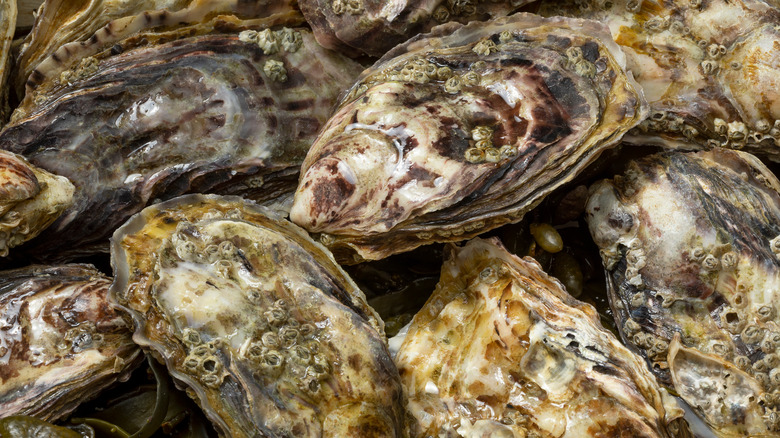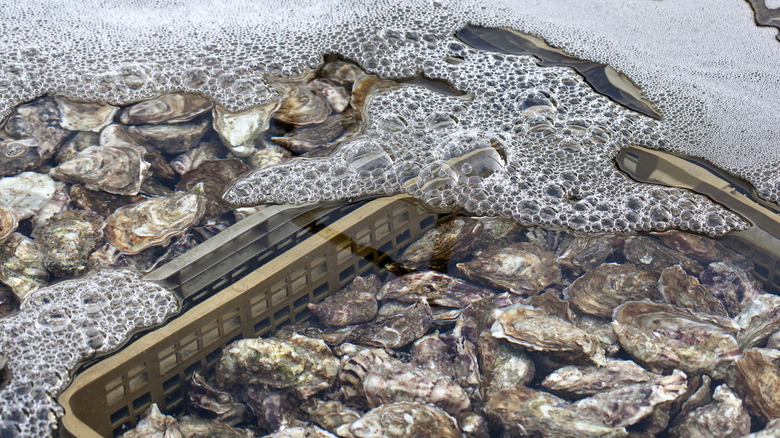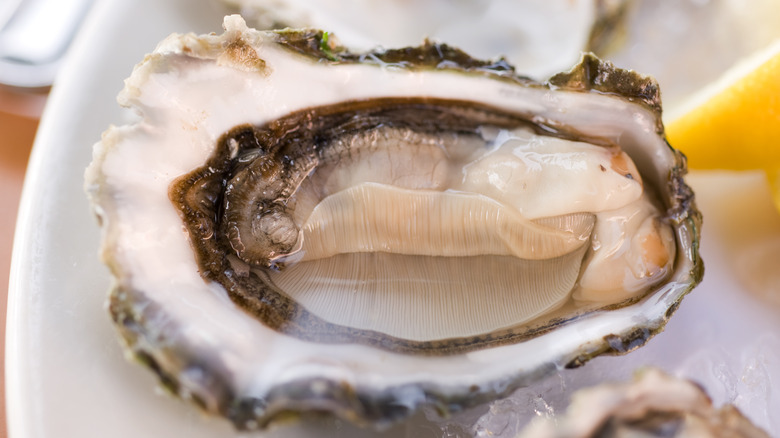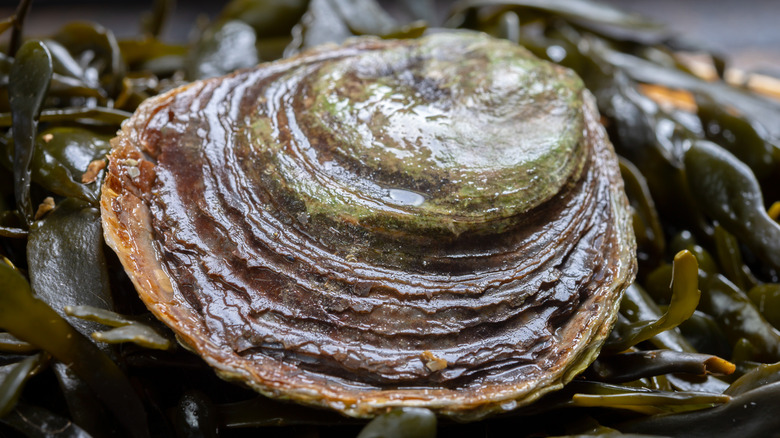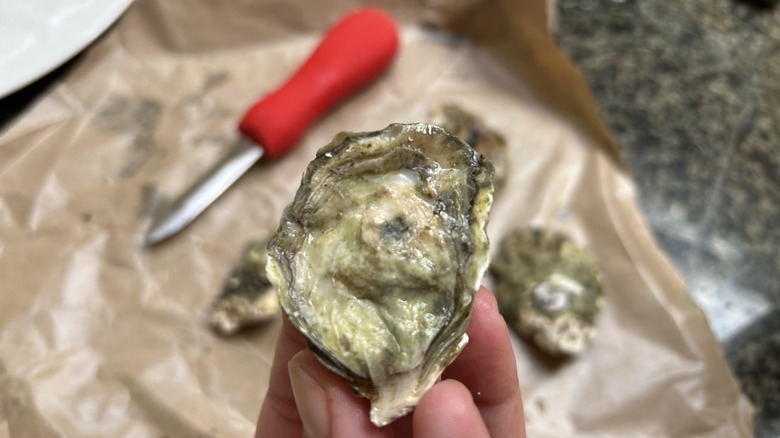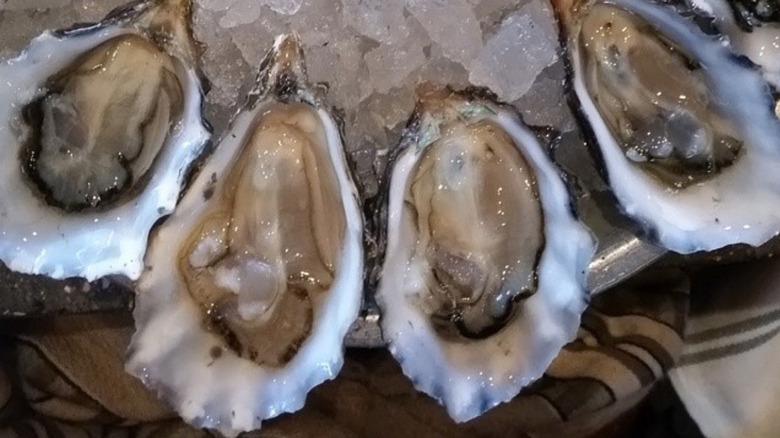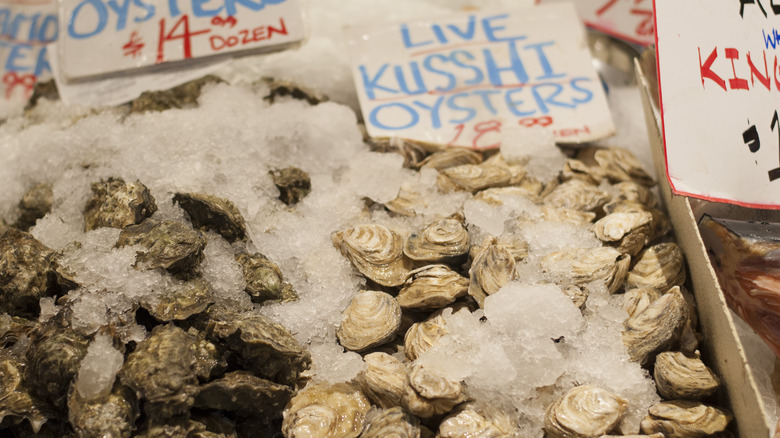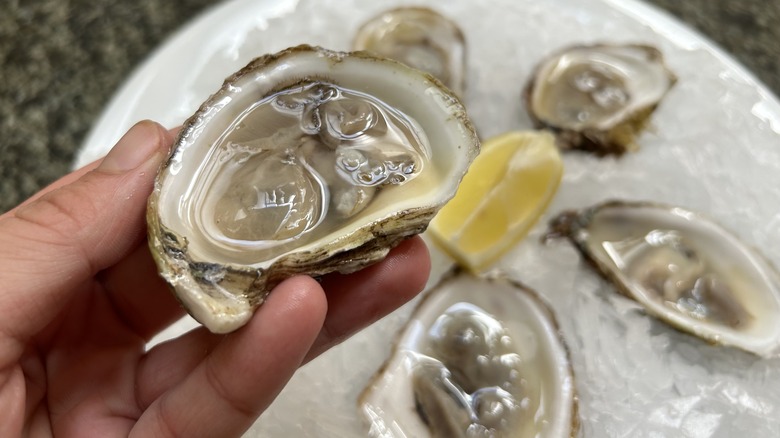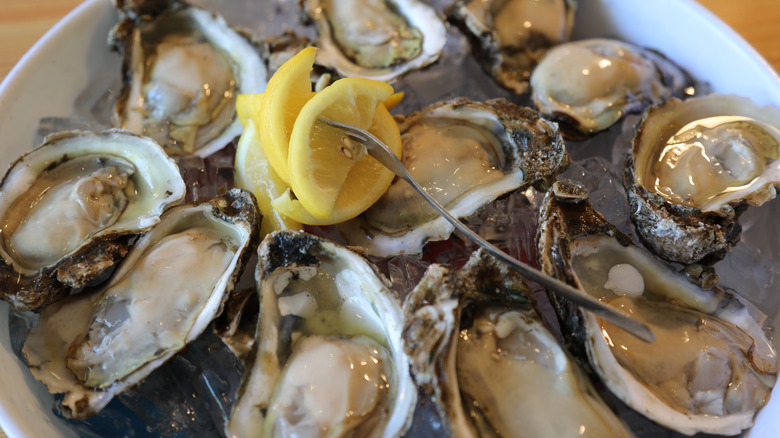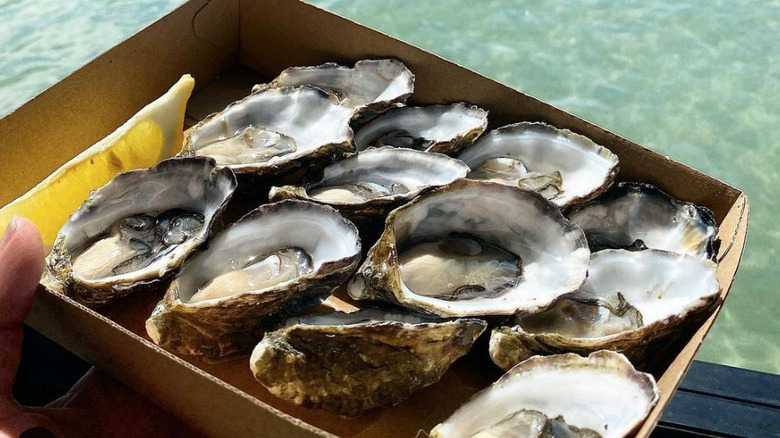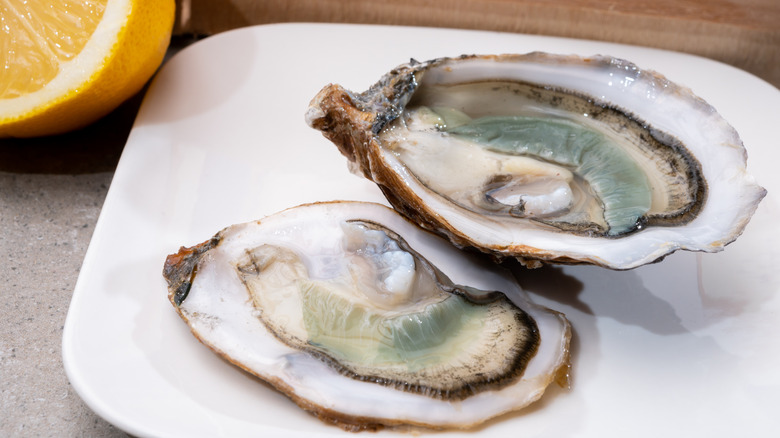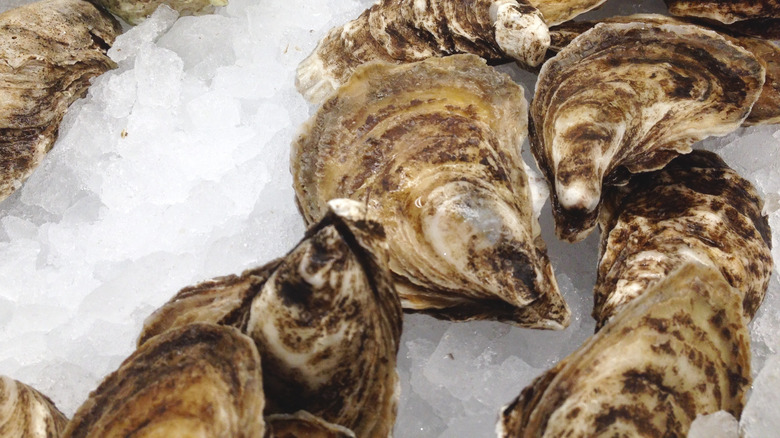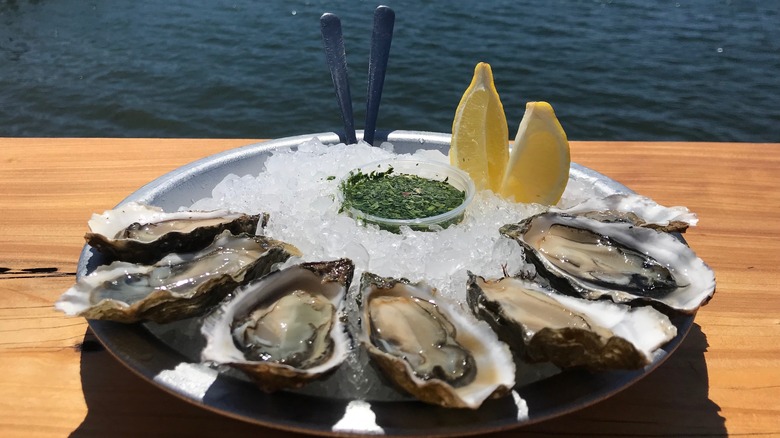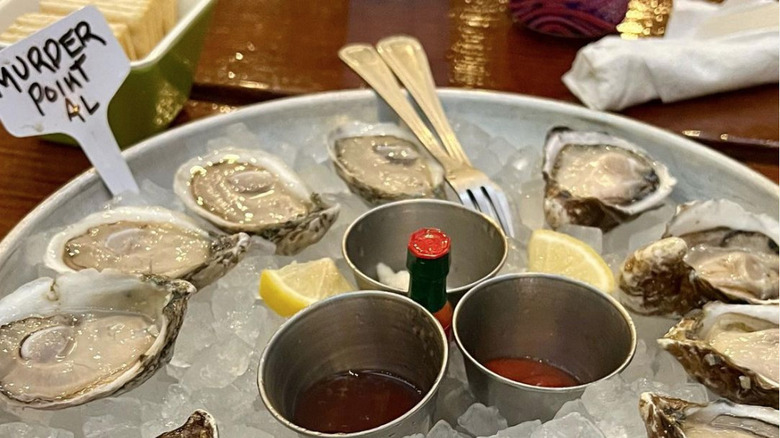5 Types Of Oysters And The Brands You Need To Know
Oysters are one of those food items everyone either abhors or adores, often with an obsessive ardor. There's something about this divisive bivalve's briny flavor profile and entirely unique texture that keeps people either far away or coming back time and time again, if only for a tiny taste. But no matter where someone falls on the scope of oyster appreciation, the fact remains that very few people out there fall anywhere between the lines of love and hate with this specific, hard-shelled seafood.
Part of the problem preventing more people from appreciating all the best aspects of oysters is that there are a lot of less-than-ideal oyster-eating opportunities out there, just waiting to happen to some unsuspecting soul. Perhaps more importantly, people often don't enjoy oysters because they don't know the abundance of species available.
Though there are only five common species of oysters consumed in North America — Atlantic, Pacific, Olympia, European Flat, and Kumamoto — there are hundreds of varieties out there, and each and every one of them is different in terms of taste, size and recommended recipes — in short, oysters are generally incomparable with one another. So, don't write off a plate of summer oysters while navigating the popular types below, and beyond; it isn't selfish to experiment with this shellfish.
1. Pacific
Pacific oysters are one of the common species of oysters and have the acclaim to come with it. This is a variety that, if eaten fresh, is as excellent raw as it is cooked on the grill. They can be served with BBQ sauce, under the broiler with garlic, parsley, and breadcrumbs, cooked into a creamy seafood pasta sauce, as a stunning stuffing ingredient in a Thanksgiving turkey, or even as a garnish for an oyster martini.
Creative culinary uses aside, the Pacific oyster has some unique qualities that set it apart. First and foremost, it's important to know that Pacific oysters, also called Miyagi oysters, hail primarily from the oceans of Japan. This oyster variety can grow to be quite large, have deep cups to hold the plentiful meat inside, and boast grey, layered-looking, and sometimes sharp shells with colors that range from mostly white to purple on the inside. The taste of Pacific oysters is often described as creamy and complex, which makes them excellent cooking oysters. The bigger the Pacific oyster, the better suited it will be for grilling instead of eating raw.
2. Atlantic
The Atlantic oyster is a must-know in the world of beloved mollusks. Also known as the Eastern oyster, this classification actually expands to encompass a fair few types of oysters across the eastern side of the Americas and along the Atlantic Ocean. When compared to the Pacific oyster variety, it is important to note that Atlantic oysters are known to have a much more salt-forward flavor that holds up well as both an uncooked, umami-filled treat and when cooked into a culinary creation.
Some recipes are best if made with Atlantic oysters as opposed to other oyster species, such as this Atlantic oyster recipe that calls for 24 Rappahannock River Oysters. When cooking with oysters, it is safer to substitute one Atlantic variety with another rather than substituting with a less similar species such as those that hail from the Pacific Ocean or the Bélon River in France, for instance.
3. Olympia
Olympia is yet another common species of oyster and is among the most beloved varieties that one could hope to find anywhere. It hails from the oceans of the Pacific Northwest and is named for Washington state's capital city. This mollusk is revered for its small size and mineral-heavy flavor profile and is a favorite oyster of James Beard winners. By striking the perfect balance between sweet, savory, and salty, the Olympia oyster has earned its place among the best oysters out there.
Although there are a fair few oysters that call the Pacific Northwest their home, these Olympia oysters are the only known native species of the region. This makes them a favorite among local mollusk lovers and far-away shellfish aficionados alike since it isn't only the flavor and texture holding up this oyster species, but prestige as well. After all, who doesn't want to at least try the original oyster of the northern Pacific Ocean?
4. European Flat
The European Flat is a species that encompasses countless varieties that are found, per their name, throughout the European continent. Some of these varieties are extremely popular in their own right, including Bélon oysters. In fact, the term "Bélon" is sometimes used interchangeably with European Flat, but the only European Flat oysters that may be called Bélon are those derived from the Bélon River in France.
When it comes to oyster species that are important to know about, it may be worth noting which made it to the incredibly simple list of ingredients that comprised Jacques Pepin's ideal last meal. That's right — the Bélon oyster is known even among celebrity culinary figures as a flavor worth being the last thing you taste. If that isn't an oyster endorsement worth listening to, what is? The flavor of Bélon oysters is clear, crisp, and crave-worthy, with a more mineral-forward flavor that makes it ideal for shucking and eating raw. Although you may serve a Bélon oyster with garnishes such as citrus, sherry vinegar, horseradish, and so on, these are perhaps the best variety for trying an unembellished oyster experience.
5. Kumamoto
The fifth and final common oyster species consumer in North America, Kumamoto oysters are a fan favorite among first-time oyster eaters and seasoned shellfish savants alike, and for good reason. This flavorful variety is a cousin of the Pacific oyster known for both its small size and for being reliably mild and pleasant in taste. Alongside the taste typically expected in the experience of eating an oyster, the Kumamoto also provides a unique melon flavor that most find to be pleasant and incredibly refreshing.
On certain summer nights, be sure to hit up the Whole Foods oyster service for some single-dollar oyster shucking. If they've got Kumamotos, go for it, since these small shellfish are singularly delicious freshly shucked and served with a bit of lemon. Kumamoto oysters are naturally found along the Washington coast and are best when shipped fresh from the source. First-time oyster eaters do well with Kumamoto oysters, especially those interested in trying a widely palate-pleasing variety that lacks a lot of the less desirable oyster qualities that can turn people off the taste.
6. Hog Island Sweetwater
Hog Island Oyster Co. is a household name when it comes to California's central coast oyster scene, and for good reason: They have the chain of command down for seamlessly shelling out servings of oysters by the (hundreds of) dozens daily. Since Hog Island Sweetwater oysters are Hog Island's specialty and are considered among the best oysters in the U.S., it's safe to say their seafood savviness reigns supreme.
These are a brand of Pacific oysters that are farmed and harvested via Tomales Bay, and then transported to various locations, including Hog Island Oyster Co. storefronts across the Bay Area. From there, they fill the bellies of appreciative diners far and wide. Hog Island Sweetwater oysters are known for being smaller than other oyster varieties, with plump meat that's a perfect balance of sweet, savory, and saltwater briny. Their small size, impeccable flavor, and clear taste are best eaten raw, although they can be deliciously cooked as well.
7. Kusshi
Kusshi oysters are not the most well-known oyster brand out there, but that doesn't mean they're any less desirable. These Pacific oysters are perfectly small and have a beautifully clean, delicate flavor that lends itself to first-time oyster eaters as much as experienced ones. These work great as a "gateway" oyster, opening the door for a larger experience.
If you run across a few Kusshi oysters for sale, they're certainly worth spending a pretty penny. After all, it's not every day that these beloved bivalves make it all the way from Vancouver Island to your local grocer. For those wanting to host an oyster-shucking party, don't skip out on the Kusshi variety. They pair perfectly with beer and wine and won't make the oyster-unenthused party guests second guess their dining decisions. In fact, Kusshi oysters might just result in converting a few new fans to oysters in general.
8. Blue Point
Blue Point oysters are one of those oyster brands that work equally well with raw, roasted, or otherwise served and prepared options — that is to say, they're one of the most versatile varieties of oysters. This Atlantic oyster variety hails from the Northeastern coast of the Americas and can primarily be found in New York and Connecticut along Long Island Sound. Blue Point oysters are a favorite among locals, but they're also widely distributed and can be found in many supermarkets that sell shellfish.
Blue Point oysters are mid-sized with smoother shells than many edible oyster varieties. They tend to boast a high amount of deliciously crisp, briny liquor. The meat of the Blue Point oyster is, in and of itself, plump, salty, and sweet tasting with no strong flavors that can turn off less experienced oyster eaters. Alongside eating these oysters raw on the half shell, consider using them as an ingredient to add some extravagance to otherwise unoriginal recipes, such as an oyster dressing recipe to stuff a traditional Thanksgiving turkey.
9. Gulf
Gulf oysters are a unique bivalve variety very much worth going out of the way to try at least once. Although these shellfish are by no means uncommon, they are far from the most well-known oyster. Though they fall under the species of Atlantic oysters, Gulf oyster is an umbrella term that can refer to many more specific kinds. Across the board, Gulf oysters are mild in flavor due to the influence of the freshwater of the Mississippi River they grow in and along.
The most typical kind of Gulf oyster will be larger than average in size with lots of meat to eat. This, combined with the already mild flavor and the close exposure to more muddy waters, makes it the perfect shellfish for some cooking. In fact, Gulf oysters are the best oysters to use to make the ever-ritzy oyster Rockefeller recipe that reigns supreme among cooked oyster dishes.
10. Coffin Bay
Coffin Bay oysters are a brand of Pacific oyster best known for being extra big, extra expensive, and generally a little bit extra exalted in the world of oyster enthusiasts. In fact, it's hard to imagine anyone seriously ranking oysters without the inclusion of these favorites.
People will travel from far and wide to try these famous Australian shellfish, sold straight from their home of Coffin Bay itself. There's something quintessentially Australian about the experience of eating a Coffin Bay oyster fresh on the half shell, savoring its sumptuous shellfish flavors while overlooking the perfectly shimmering waters it came from in the hot Australian sun (and preferably with a cold Australian beer).
Coffin Bay oysters are expensive for a reason, and that reason isn't just the size, though that certainly doesn't hurt. No, Coffin Bay oysters are also singularly crisp, salty, and savory — and not just in Australia, but across the globe's most prolific coastlines as well.
11. Fine de claire (and verte)
The Fine de Claire variety of oyster is a Pacific one that may also be called Green Gill oysters; these green-tinted mollusks are genuinely unique ocean beauties, truly rare treats that can be farmed and foraged to make tempting half-shell hors d'oeuvres for any table. But what makes green gill oysters so unique? Well, for starters, they are lauded not for their plumpness but for their less substantial inner meats.
Whereas some oysters can be ... a bit of a mouthful, Fine de Claire oysters are guaranteed to slip down with ease. This leanness, combined with their smooth and clean, thoroughly inoffensive flavor (in every regard), makes them ideal for first-time oyster eaters who want to get the best bite for their buck. On the flip side, experienced eaters of all things oysters can and most certainly should indulge, at least once, in a Fine de Claire culinary experience.
12. Beausoleil
Yet another subsect species of the beloved Atlantic oyster variety, Beausoleil oysters are tasty mollusks that originate just north of Maine, in Canada's southeastern province of New Brunswick. Beausoleil is a brand of oysters worth knowing, apart from the other incredible oysters out there, due to their potential in the fine dining sphere. Specifically, Beausoleils are often are frequently coveted by gourmands and chefs alike, either to be eaten raw on the half shell or to add a little extra something to an already exemplary dish or drink. For instance, this oyster variety is used in fine dining or as a fancy cocktail and caviar garnish, as seen in NYC fine dining menus.
While other oysters can lack a certain je ne sais quoi in terms of refined tastes, the Beausoleil oyster is all class and culture, captured in the smooth cup of the shell. Each bite should be sweet, plump, and with a satisfying saltiness that evokes sensations of the sea.
13. Pacific Preston Point
Pacific Preston Point oysters are not a particularly common oyster and are most often served at one of the best seafood shacks in the nation, The Marshall Store. This brand of Pacific oyster tastes absolutely amazing raw or grilled with toppings such as bbq and bacon (yum). Although these oysters are far from small, the actual meat of the oyster itself lacks that overwhelming oyster mouthfeel that many Pacific varieties can lend. Instead, Pacific Preston Point oyster eaters can expect to taste a burst of almost Atlantic oyster-like salinity with a pleasantly crisp aftertaste.
At The Marshall Store, the smallest of Pacific Preston Point oysters are kept to serve raw on the half shell over ice (with a few lemons and a stellar cilantro and vinegar side), while the larger of the lot are grilled up with great garnishes, served with garlic bread, and eaten overlooking the very same Tomales Bay in which these mollusks were farmed and foraged.
14. Murder Point
Murder Point Oyster Co. doesn't just serve up delicious oysters to the hungry masses — they do it with some flair. Whether or not the salacious gossip about warring oyster families dueling it out to the death over an oyster feud is true, the fact remains that generations of gourmet oyster providers are going strong in getting these Murder Point oysters out there. This is especially true in the home state of the Murder Point oyster: Alabama.
Murder Point brand oysters are classified as Gulf oysters (which are in turn classified as Atlantic oysters) and as such share many of the same flavor qualities one might expect of other oysters fed and influenced by the Mississippi River or the Gulf of Mexico. What sets Murder Point oysters apart from other brands is not only their notoriety in having an ever-so-slightly macabre name, but also for a uniquely buttery, briney, and downright blissful taste that's to die for.
